 |
Cetățuia de pe Strajă
Brașov, Romania
|
|
 |
Constructed: 1580 - 1630
Used by: Wallachia,
Austria, Russia, Romania
Conflicts in which it participated:
none
Also known as: Sentry Fortress,
Castle Hill
|
Humans first started doing the things that humans tend to do in what would become the city of Brasov as early as 9500BC. The first fortification there was a citadel built by the Dacians, a people who thrived in the Carpathian Mountains west of the Black Sea during the Iron Age, which is vaguely considered to be around 1300BC to 700AD.
Brasov, fortunately or unfortunately depending on your perspective, found itself on the front lines of the centuries-long struggle betwixt the Kingdom of Hungary and the Ottoman Empire. |
 |
|
|
Conveniently located on a trade route between those two warring entities, Hungary encouraged "Transylvanian Saxons" (which we would today call "Germans") to settle in the region. This was intended to populate Hungary's border with industrious, non-Ottoman persons.
This scheme was further advanced in 1211 when Hungary's King Andrew II (1177-1235) accepted the services of the Teutonic Knights in the defense of his kingdom's southern and eastern borders. The Teutonic Order built a city called Kronstadt (City of the Crown) at the little village of Brasov, but were tossed out by King Andrew in 1225 when the Knights maneuvered to transfer their loyalty from the King of Hungary to the Pope. The German settlers who came with the Knights, however, stayed put.
|
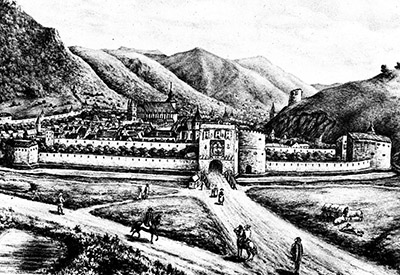 The fortified city of Brasov, prior to the fire of 1689. The fortified city of Brasov, prior to the fire of 1689. |
 |
The first fortification on Brasov's "Sentry Hill" (where the starfort of our current interest now resides) was built in 1529, in an effort to defend against an expected attack by Moldovian Voivode (warlord) Petru Rareș (1487-1546).
Rareș, fighting on behalf of what would ultimately be the losing side of a royal Hungarian power struggle, besieged Brasov for several weeks in October of 1529. Whatever this first fortification was (likely a wooden bastion with four towers), it proved sufficient to the task of preventing a guy with a comma attached to the bottom of the "s" in his name to conquer it. |
|
Something enticingly referred to as "artillery towers" were added at or around the fort in the 1550's, but the cetățuia of our current interest didn't start looking like a starfort until the early 17th century. This iteration of the fort burned to the ground in 1618, and was then rebuilt in 1625, with its four corner bastions being completed in 1630. Starfort accomplished!
|
From the 14th century until the 1880's, much of what would become Romania was known as Wallachia. Though a starfort built in Brasov in 1630 would thus technically be Wallachian, the Cetățuia de pe Strajă would have been intended to project local power, such as that of "Judge Mayor" Cristel Hirscher, whose administration reigned when the fort was completed.
Precariously teetering on the fence betwixt the Ottoman and Habsburg empires (but more in line with the Ottomans for the previous few centuries), Brasov had come firmly under the control of the Habsburgs by the mid-17th century.
|
 |
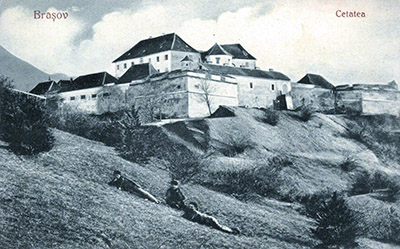 The Fortress Garrisons on a fashionable postcard from the 19th century. Bored much, lounging Romanian boys? The Fortress Garrisons on a fashionable postcard from the 19th century. Bored much, lounging Romanian boys? |
|
This did not universally meet with pleased local consent, however, and in 1688 the city rebelled against its Habsburgian masters: This revolt was swiftly and brutally quashed in the standard Habsburggy style. Our Cetățuia may have been built to further local concerns, but it was now a Habsburg stronghold.
A fire ravaged Brasov on April 21, 1689. Just about everything in the city was destroyed, except of course for the awesome masonry starfort on the hill. When rebuilding commenced, wooden structures were outlawed. The city's restoration naturally took a long time due to this restriction, but what resulted was a fireproof city.
|
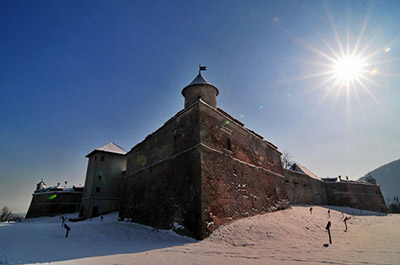 The Cetățuia de pe Strajă's western bastion. And the Romanian sun, which is a totally different sun than the one we use in the western hemisphere. The Cetățuia de pe Strajă's western bastion. And the Romanian sun, which is a totally different sun than the one we use in the western hemisphere. |
 |
In the early 1700's, the Cetățuia was surrounded with a ditch and earthen embankments, to further enhance both its defensibility and ability to withstand artilleristic intervention. Another spasm of improvement took place in the years following 1773, resulting in the hexagonal tower that stands today in the fort's center; 'twas an addition to the existing castleish fort that had been surrounded by starforty aspects in the previous century.
The endless conflicts betwixt the Ottomans and everybody else within a thousand miles of them continued, and by the dawn of the 1820's, Wallachia was mostly back in the thrall of the Ottomans. |
|
In addition to the usual Austrian Habsburgs, the region was also being wrestled over by Greeks and Russians, all of which coalesced in the Wallachian Uprising of 1821. By 1829 Wallachia was under Russian military rule, which improved the average Wallachian's lot by allowing him to trade with merchants from any nation he chose, as opposed to only with Ottomans, as had previously been the case. See? Just because the Russians were in charge didn't always mean you were actively being raped and pillaged!
|
|
The interior of the Cetățuia de pe Strajă today seems quite lush and tidy, and is obviously lovingly maintained. But watch where you're pointing that weird cannon, Brasovians! |
By 1848, Wallachia was again part of the Ottoman Empire. Many people in France, Austria, the German States, Denmark, Hungary, Poland and the Italian States suddenly got it into their heads that it would be so very nice if they didn't have to live under the feudal, monarchal weirdness that had been the governing force of their lives for the past several centuries, and rebelled against their local authorities. These events became known as the Revolutions of 1848.
|
Though in every case these rebellions were squished both immediately and mercilessly and generally resulted in not much of anything other than dead people, many Wallachians (who had been simmering in a revolutionary fashion for years anyway) thought rebellion was a fine idea, and joined in the 1848 fun. On June 11 and 12, a revolutionary mob in Wallachia's capitol of Bucharest managed to depose Gheorghe Bibescu (1804-1873), Hospodar (lord) of Wallachia. After three months of what was certain to have been a chaotic sort of freedom, Ottoman intervention reimposed Ottoman authority in September. Turkish and Russian troops remained in Bucharest until 1851.
|
 |
|
|
Through all of this political upheaval, the Cetățuia de pe Strajă was utilized as a prison, holding whomever was in need of imprisonment at the time. Because there's always somebody in need of incarceration.
|
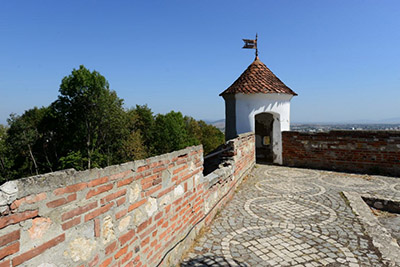 The pointy end of each of the Cetățuia de pe Strajă's four bastions are graced with a guerite, which probably has a way cooler name in Romanian. The pointy end of each of the Cetățuia de pe Strajă's four bastions are graced with a guerite, which probably has a way cooler name in Romanian. |
 |
Wallachia and Moldavia, another principality to Wallachia's north, had been agitating together for unification with each other, and independence from the Ottomans, Austrians, Russians, Zulus or whomever, since the uprising of 1821. Following the Russo-Turkish War of 1877-78, in which Romania fought on the victorious Russian side, Romania was finally recognized as an independent state. Following the First World War (1914-1918), the Treaty of Alba Iulia (whose ceremony was held within the walls of another Romanian starfort, Alba Carolina) granted Transylvania to Romania as well, bringing the nation to roughly the size it is today. |
|
Romania spent the Second World War (1939-1945) being compelled to join the Axis by the Soviet Union, supplying most of Nazi Germany's oil and thus being the recipient of the most fierce bombing campaign that the Allies could muster, being compelled to send nearly a million troops to assist with the German invasion of the Soviet Union, leaving the Axis and joining the Allies, and ultimately being occupied by the Soviet Union and forced to join the Soviet Boc at the war's conclusion.
In the west, Romania's Communist period is generally viewed as being pretty dreadful, but I wasn't there, so maybe it was all butterflies and snickerdoodles. Which would have been why General Secretary of the Romanian Communist Party Nicolae Ceaușescu (1918-1989) was hunted down by a mob and shot in 1989: Not enough cinnamon in the snickerdoodles.
|
One of the first large-scale revolts against the Ceaușescu regime, which was draconian even by Soviet Bloc standards, took place in Brasov in 1987. On November 15, around 20,000 workers from the Brasov Tractor Plant, fed up with privations and wage decreases caused by an ineptly-handled economy, marched on City Hall and trashed it. By nightfall security forces had dispersed the crowd and arrested 300 persons, but nobody was killed or seriously hurt.
The Cetățuia de pe Strajă spent 1955 to 1975 as a warehouse for Romania's State Archives. A concerted effort began to restore the fort to its former glory in 1981, and since then it has served as a "touristic complex with medieval peculiarity."
|
 |
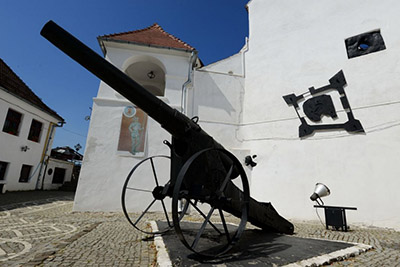 That's a pretty silly-looking gun you've got there, Straja...but a beautiful starfort depiction on the wall behind it! That's a pretty silly-looking gun you've got there, Straja...but a beautiful starfort depiction on the wall behind it! |
|
Many thanks to alert starfort enthusiast Corneliu Grafita for bringing the Cetățuia de pe Strajă to our attention!
|
|
|
|
|
|
 |




